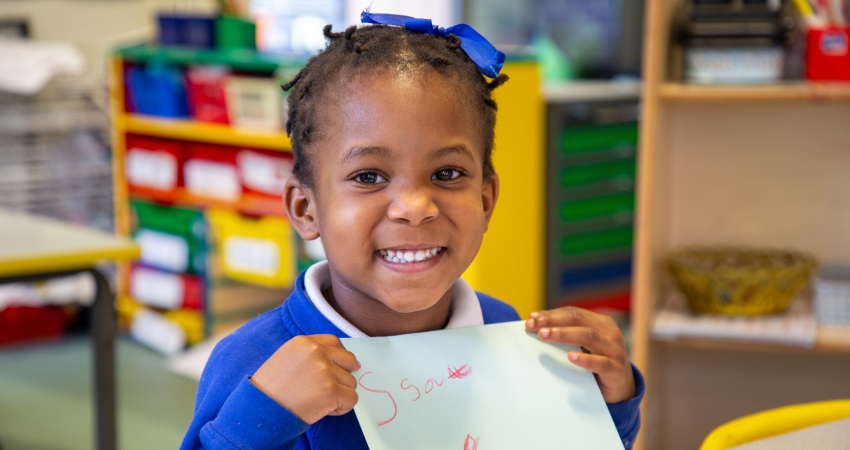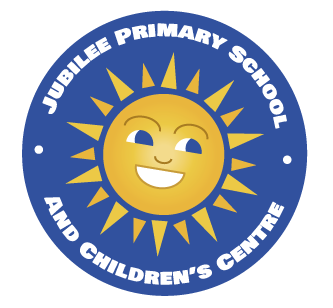Phonics at Jubilee
Subject leader: Kim Harwood

Intent
At Jubilee Primary School we use ‘Little Wandle Letters and Sounds Revised’. We believe that ‘ Little Wandle Letters and Sounds is a synthetic and systematic phonics programme that is effective in teaching pupils to read, spell and write. It begins teaching from what all children know from a very early age – the sounds of their own language. From there, it takes them in carefully sequenced, incremental steps and teaches them how each of the 44 or so sounds in the English language can be spelt.
Within this conceptual framework, we teach the factual knowledge required to become an effective reader and speller: the approximately 176 spellings that represent the 44 or so sounds in English, starting with the most-simplest one-to-one correspondences.
As a result, all our children are able to tackle any unfamiliar words as they read. At Jubilee Primary School we also model the application of the alphabetic code through phonics in shared reading and writing, both inside and outside of the phonics lesson and across the curriculum. We have a strong focus on language development for our children because we know that speaking and listening are crucial skills for reading and writing in all subjects.
We start teaching phonics in Nursery and follow the Little Wandle Letters and Sounds Revised progression, which ensures children build on their growing knowledge of the alphabetic code, mastering phonics to read and spell as they move through school.
Children will know:
-
that letters are spellings of sounds: visual language is a representation of spoken language
-
that a spelling can contain one, two, three, or four letters - examples are: s a t,
-
f i sh, n igh t and w eigh t
-
that there is more than one way of spelling most sounds: the sound 'ae', spelt as <a-e> in 'name', can be represented as <a> in 'table', <ai> in 'rain', <eigh> in 'eight', <ay> in 'play', and so on
-
that many spellings can represent more than one sound: <ea> can be the sound 'e' in 'head', 'a-e' in 'break', or 'ee' in 'seat'
Reading and spelling also requires expertise in the skills necessary to make use of the alphabet code and pupils need to be able to:
-
segment, or separate sounds in words
-
blend, or push sounds together to form words
-
manipulate sounds: take sounds out and put sounds into words
We follow Little Wandle Letters and Sounds, as it provides opportunities for practising these skills on a daily basis until pupils achieve the automaticity required for fluent reading and spelling.
Implementation
Our phonics program teaches through the following six stages:
-
Foundations for Phonics (Teach in Nursery)
-
Phase 2 (Begin teaching in reception Autumn 1)
-
Phase 3 (Begin teaching in reception Spring 1)
-
Phase 4 (Begin teaching in reception Summer 1)
-
Phase 5 (Teach throughout year one)
-
Support for spelling and Reading Masters (Teach throughout year two)
Foundations for phonics in Nursery
We provide a balance of child-led and adult-led experiences for all children that meet the curriculum expectations for ‘Communication and language’ and ‘Literacy’.
These include:
-
sharing high-quality stories and poems
-
learning a range of nursery rhymes and action rhymes
-
activities that develop focused listening and attention, including oral blending
-
attention to high-quality language.
We ensure Nursery children are well prepared to begin learning grapheme-phoneme correspondences (GPCs) and blending in Reception.
Reception and Year One
Children receive daily phonics lessons (30 minutes) in Reception and Year One. Children in Reception are taught to read and spell words using Phase 2 and 3 GPCs, and words with adjacent consonants (Phase 4) with fluency and accuracy. Children in Year 1 review Phase 3 and 4 and are taught to read and spell words using Phase 5 GPCs with fluency and accuracy.
Daily Keep-up lessons ensure every child learns to read
-
Any child who needs additional practice has daily Keep-up support, taught by a fully trained adult. Keep-up lessons match the structure of class teaching, and use the same procedures, resources and mantras, but in smaller steps with more repetition, so that every child secures their learning.
-
We timetable daily phonics lessons for any child in Year 2 or 3 who is not fully fluent at reading or has not passed the Phonics Screening Check. We use the Little Wandle Letters and Sounds Revised assessments to identify the gaps in their phonic knowledge and teach to these using the Keep-up resources – at pace, until they are ready to move onto the Reading Masters Programme.
-
If any child in Year 3 to 6 has gaps in their phonic knowledge when reading or writing, we plan phonics ‘catch-up’ lessons to address specific reading/writing gaps. These short, sharp lessons last 10 minutes and take place at least three times a week.
Planning
Each Phonics lesson in EYFS and KS1 include the following sections:
-
Revisit and Review– Overlearn the previous graphemes, words and tricky words.
-
Teach and Practise- Introduce a new grapheme using catchphrase. Practise reading words
-
Practise and Apply – Read sentences and practise spelling with new grapheme.
-
Assess – Teacher to assess throughout lesson for assessment for learning. Some children may need catch-up support or individual 1:1 support throughout the day if not on track.
Weekly content grids map each element of new learning to each day, week and term for the duration of the programme. Lesson templates, Prompt cards and How to videos ensure teachers all have a consistent approach and structure for each lesson.
Teaching reading: Reading practice sessions three times a week
We teach children to read through reading practice sessions three times a week.
These:
-
are taught by a fully trained adult to small groups of approximately six children
-
use books matched to the children’s secure phonic knowledge using the Little Wandle Letters and Sounds Revised assessments and book matching grids on pages 11–20 of ‘Application of phonics to reading’
-
are monitored by the class teacher, who rotates and works with each group on a regular basis.
Each reading practice session has a clear focus, so that the demands of the session do not overload the children’s working memory. The reading practice sessions have been designed to focus on three key reading skills:
-
decoding
-
prosody: teaching children to read with understanding and expression
-
comprehension: teaching children to understand the text.
In Reception these sessions start in Week 4. Children who are not yet decoding have daily additional blending practice in small groups, so that they quickly learn to blend and can begin to read books. In Year 2 and 3, we continue to teach reading in this way for any children who still need to practise reading with decodable books.
Home Learning
Parental involvement is key in the acquisition of Phonics. We use the Little Wandle Letters and Sounds Revised parents’ resources to engage our families and share information about phonics, the benefits of sharing books, how children learn to blend and other aspects of our provision, both online and through workshops.
Each child in Reception and Year 1 receives home learning containing the tricky words and sounds of the week for children to practise. At the beginning of the year, children will be given the 45 reception high frequency words to take home as flashcards and Year 1 children are given the 100 High frequency words, which they are expected to be able to read and write by the end of the year as well as a Phase 5 sound mat. Children in Year 2 and KS2 receive common exception word lists which are sent home to support spelling. Also at the beginning of the academic year parents are provided with phonic supporting visuals such as sound mats which contain the graphemes to be learnt.
All children are sent home weekly with phonic reading books which complement the sounds they have been taught. Reading for pleasure books also go home for parents to share and read to children.
Parent meetings are held for parents of children in EYFS and Year one which outline how we teach phonics and how they can support their child when reading and writing at home. Year One parents are also invited to attend a workshop on the Year One Phonic Screening test.
Classroom Environment and Phonics Teaching Spaces
In each class there is an age appropriate phonics display, concentrating on both phonemes and key words of the week. In Reception there are phonics activities set-up linking to the phonemes of the week for children to independently apply their knowledge.
Every Phonics teaching space should be equipped with a display of the ‘phonemes of the week’ and ‘tricky words of the week’, whiteboards, whiteboard pens, a larger whiteboard to model on and where possible access to an Iboard. Each phonics group should also have a puppet that is used by an adult when modelling. Teachers should have a special box for ‘What’s in the box’ and have word cards organised ready to teach daily sessions.
Every classroom has an inviting book corner that encourages a love for reading. We curate these books and talk about them to entice children to read a wide range of books. In Nursery and Reception, children have access to the reading corner every day in their free flow time and the books are continually refreshed.
Impact
Assessment procedures
Children’s progress in developing and applying their phonic knowledge
is carefully assessed and monitored. This includes assessing the children’s subject knowledge of individual graphemes taught as well as their ability to blend and segment when reading and writing.
Children are tracked using the Little Wandle Letters and Sounds assessment online tracking tool every 6 weeks to assess progress and on Target Tracker for reading and writing. Teachers use daily phonics sessions to monitor children’s progress and assess children through their writing and reading to identify who needs ‘Keep-up support’. All staff from Early Years to year two have pupil-progress meetings to ensure all children are set appropriately and all assessments are accurate.
In Year 1 children will take the Phonics Screening Check. This usually occurs in the second week of June. Children are asked to read 40 words and non-words (nonsense words). The 40 words and non-words are divided into two sections, one with simple word structures of 3 or 4 letters and one with more complex word structures of 5 or 6 letters. Previously children had to read 32 or more words correctly to pass, but this is subject to change. This assessment will confirm whether individual pupils have learnt phonic decoding to an appropriate standard. Phonic screening check mocks are carried out early to identify children who need to be given additional support to meet the required standard. If a child does not reach the appropriate standard, then further support is put in place in order for the child to make accelerated progress with their reading and writing. Any child not passing the check re-sits it in Year 2.
If you would like to find out more about the phonics curriculum at Jubilee, please email admin@jubilee.lambeth.sch.uk and write F.O.A Kim Harwood and they will respond to the enquiry.
